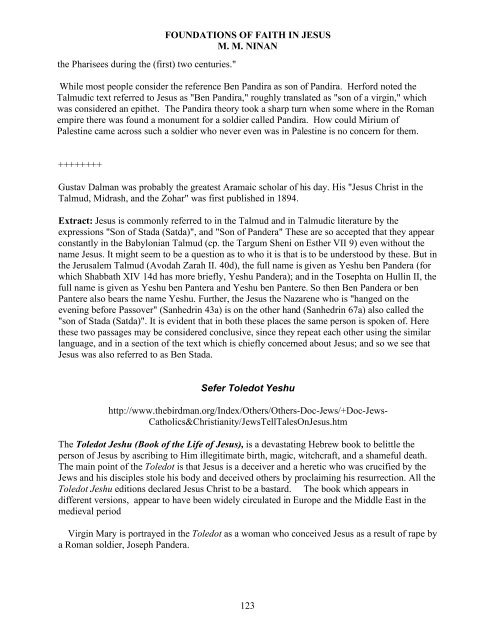Foundations of Faith
Create successful ePaper yourself
Turn your PDF publications into a flip-book with our unique Google optimized e-Paper software.
the Pharisees during the (first) two centuries."<br />
FOUNDATIONS OF FAITH IN JESUS<br />
M. M. NINAN<br />
While most people consider the reference Ben Pandira as son <strong>of</strong> Pandira. Herford noted the<br />
Talmudic text referred to Jesus as "Ben Pandira," roughly translated as "son <strong>of</strong> a virgin," which<br />
was considered an epithet. The Pandira theory took a sharp turn when some where in the Roman<br />
empire there was found a monument for a soldier called Pandira. How could Mirium <strong>of</strong><br />
Palestine came across such a soldier who never even was in Palestine is no concern for them.<br />
++++++++<br />
Gustav Dalman was probably the greatest Aramaic scholar <strong>of</strong> his day. His "Jesus Christ in the<br />
Talmud, Midrash, and the Zohar" was first published in 1894.<br />
Extract: Jesus is commonly referred to in the Talmud and in Talmudic literature by the<br />
expressions "Son <strong>of</strong> Stada (Satda)", and "Son <strong>of</strong> Pandera" These are so accepted that they appear<br />
constantly in the Babylonian Talmud (cp. the Targum Sheni on Esther VII 9) even without the<br />
name Jesus. It might seem to be a question as to who it is that is to be understood by these. But in<br />
the Jerusalem Talmud (Avodah Zarah II. 40d), the full name is given as Yeshu ben Pandera (for<br />
which Shabbath XIV 14d has more briefly, Yeshu Pandera); and in the Tosephta on Hullin II, the<br />
full name is given as Yeshu ben Pantera and Yeshu ben Pantere. So then Ben Pandera or ben<br />
Pantere also bears the name Yeshu. Further, the Jesus the Nazarene who is "hanged on the<br />
evening before Passover" (Sanhedrin 43a) is on the other hand (Sanhedrin 67a) also called the<br />
"son <strong>of</strong> Stada (Satda)". It is evident that in both these places the same person is spoken <strong>of</strong>. Here<br />
these two passages may be considered conclusive, since they repeat each other using the similar<br />
language, and in a section <strong>of</strong> the text which is chiefly concerned about Jesus; and so we see that<br />
Jesus was also referred to as Ben Stada.<br />
Sefer Toledot Yeshu<br />
http://www.thebirdman.org/Index/Others/Others-Doc-Jews/+Doc-Jews-<br />
Catholics&Christianity/JewsTellTalesOnJesus.htm<br />
The Toledot Jeshu (Book <strong>of</strong> the Life <strong>of</strong> Jesus), is a devastating Hebrew book to belittle the<br />
person <strong>of</strong> Jesus by ascribing to Him illegitimate birth, magic, witchcraft, and a shameful death.<br />
The main point <strong>of</strong> the Toledot is that Jesus is a deceiver and a heretic who was crucified by the<br />
Jews and his disciples stole his body and deceived others by proclaiming his resurrection. All the<br />
Toledot Jeshu editions declared Jesus Christ to be a bastard. The book which appears in<br />
different versions, appear to have been widely circulated in Europe and the Middle East in the<br />
medieval period<br />
Virgin Mary is portrayed in the Toledot as a woman who conceived Jesus as a result <strong>of</strong> rape by<br />
a Roman soldier, Joseph Pandera.<br />
123


















